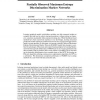13 search results - page 2 / 3 » Margin-based first-order rule learning |
AAAI
1994
13 years 6 months ago
1994
We describe a method for learning formulas in firstorder logic using a brute-force, smallest-first search. The method is exceedingly simple. It generates all irreducible well-form...
IJCAI
2007
13 years 6 months ago
2007
We present a fully connectionist system for the learning of first-order logic programs and the generation of corresponding models: Given a program and a set of training examples,...
ICMLA
2010
13 years 2 months ago
2010
Abstract--In the Relational Reinforcement learning framework, we propose an algorithm that learns an action model allowing to predict the resulting state of each action in any give...
MLDM
2001
Springer
13 years 9 months ago
2001
Springer
Abstractions and Case-Based Reasoning for Medical Course Data: Two Prognostic Applications . . . . . . . . . . . . . . . . . 23 R. Schmidt and L. Gierl Are Case-Based Reasoning and...
NIPS
2008
13 years 6 months ago
2008
Learning graphical models with hidden variables can offer semantic insights to complex data and lead to salient structured predictors without relying on expensive, sometime unatta...

